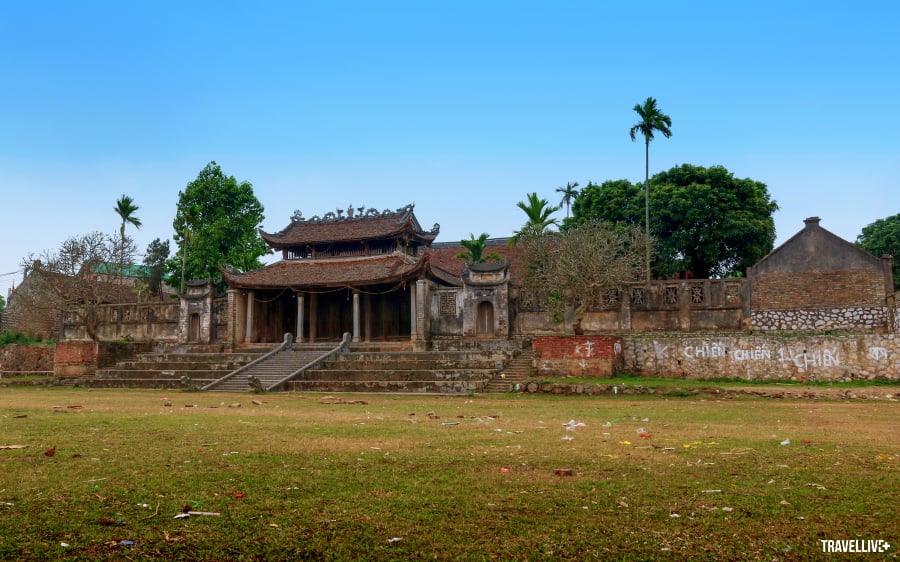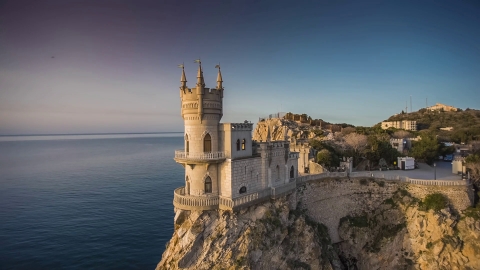Communal houses, temples and pagodas are all traditional ancient architectural forms of the Vietnamese people, often associated with village culture and influenced by Vietnamese social circumstances. It can be said that communal houses, temples and pagodas are the face of the ancient architectural and artistic foundation of the Vietnamese people and are a treasure trove for exploiting a lot of knowledge about history, culture, archaeology, Han Nom, etc. In particular, with sacred spiritual meaning, the construction locations of communal houses, temples and pagodas are often associated with beautiful landscapes, many places can be considered as worldly landscapes attracting pilgrims and tourists.
Vietnamese Pagoda - a combination of Buddhism and indigenous beliefs
Buddhism entered Vietnam very early, many studies suggest that it was from the beginning of the Common Era. Buddhism entered Vietnam quickly and combined with indigenous beliefs, leading to the need to form architectural works to worship Buddha. Therefore, pagodas may have existed early and current traces show that pagodas developed strongly during the Ly - Tran dynasties when Buddhism became the national religion of our country. At that time, pagodas were probably built everywhere. Up to now, due to harsh nature, many renovations and the consequences of war, the remaining pagodas are no longer intact.
Boi Khe PagodaBoi Khe Pagoda, whose Chinese name is "Dai Bi Tu", is located in Song Khe village, Tam Hung commune, Thanh Oai district. In addition to its scale and beautiful landscape, Boi Khe Pagoda also has special value in terms of architecture and fine arts of the Vietnamese people. According to the stele, the pagoda was built in the 10th year of Khai Huu (1338). The stele also states that the pagoda was destroyed by the Ming army, then restored, rebuilt and expanded in later generations, so it can be seen that the architecture and carvings of Boi Khe Pagoda carry many artistic styles of different periods. The oldest artifacts still preserved in the pagoda are the rectangular stone Buddha pedestal with a specific date (1382) and some dragon carvings on bronze boards and seven upper hall porches with the artistic style of the Tran Dynasty. The upper hall still retains two sets of roofs with the artistic style of the Mac Dynasty. However, on the outside, the front hall has the architecture of the Nguyen Dynasty. In addition, behind Boi Khe Pagoda is the shrine of Saint Nguyen Binh An. This building has a nearly square architectural plan, the roof is made in the style of overlapping beams and is placed on a truss system, looking quite special.
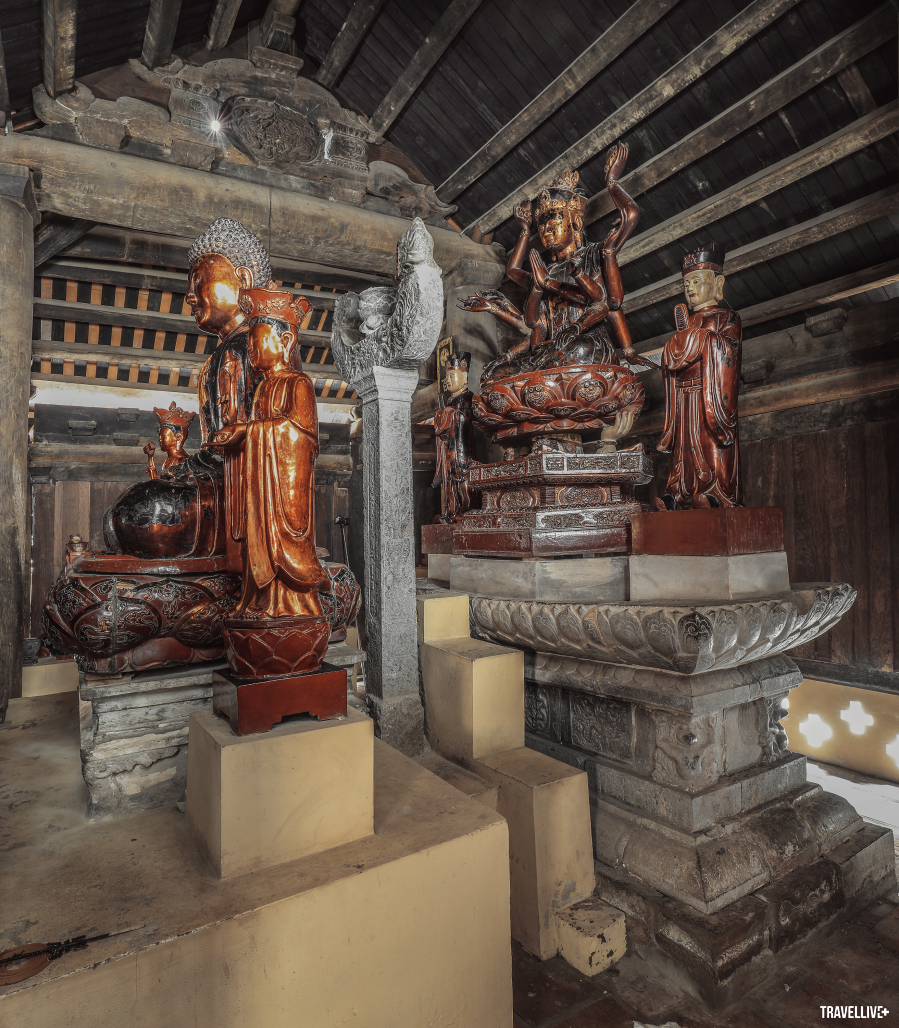
Statue of Guanyin of the South China Sea on a stone Buddha pedestal of the Tran Dynasty

The roof trusses of the upper palace during the Mac Dynasty

Front hall of Boi Khe pagoda
Thay PagodaLocated in the rocky mountain area of Sai Son, Hoang Xa, Phuong Cach in Quoc Oai town, Hanoi city. Thay Pagoda has the Chinese name "Thien Phuc Tu" and has been ranked as a special national architectural and artistic relic. Thay Pagoda is one of the pagodas with the most beautiful terrain and landscape in Vietnam. According to legend, the entire main pagoda was built on a dragon-shaped land, with its back leaning on Sai Son mountain and its face facing Long Tri lake. Sai mountain is the dragon, the pagoda is built on the dragon's forehead, the pagoda yard is the dragon's tongue, the two wells are the dragon's eyes, Nhat - Nguyet fairy bridge are the dragon's two whiskers, and the water pavilion on the lake is the dragon's pearl. The main pagoda consists of three parallel buildings called Ha pagoda, Trung pagoda and Thuong pagoda. Ha pagoda and Trung pagoda are connected by a tube to form the position "Ha Cong, Thuong Nhat". The pagoda's architecture today mainly has the artistic style of the Later Le Dynasty, however, Thay Pagoda preserves many older artifacts from different periods such as the stone Buddha pedestal shaped like a lion wearing a lotus throne from the Ly Dynasty, the stone Buddha pedestal, the worshiping throne from the Tran Dynasty, the statue pedestal from the Early Le Dynasty, the altar, the statue pedestal from the Mac Dynasty... It can be said that Thay Pagoda is like a museum preserving ancient artifacts of high artistic value.
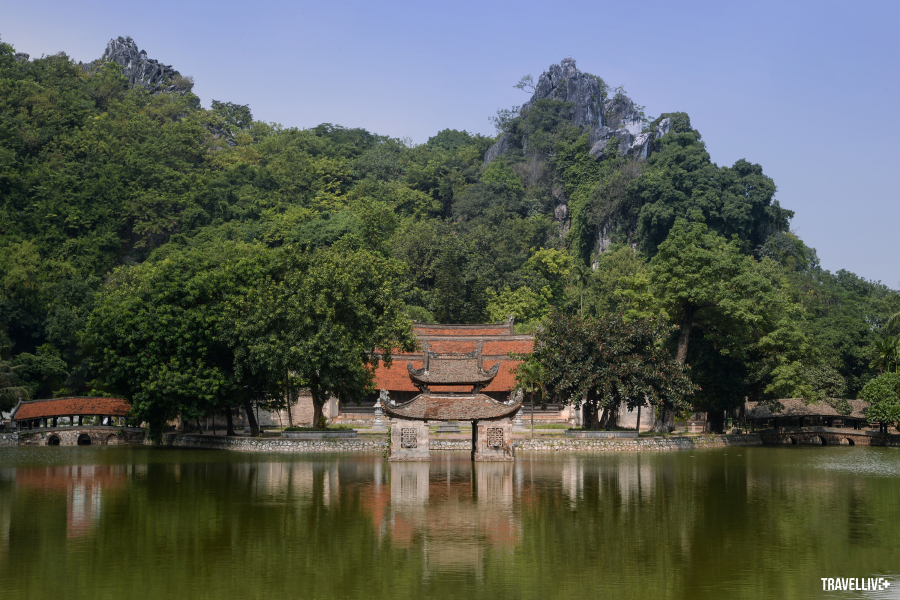

Tay Phuong PagodaLocated in Thach Xa commune, Thach That district. The pagoda has the Chinese name "Sung Phuc Tu" and has been ranked as a special national architectural and artistic relic. The entire pagoda grounds are located on a high mountain. When passing through the lower three-door gate at the foot of the mountain, there is a path leading up to the pagoda made of solid laterite steps, with both sides being a mountain and forest landscape. The main pagoda consists of three buildings with a two-story overlapping roof architecture arranged in the shape of the letter "Tam". In particular, Tay Phuong pagoda also preserves a system of Buddha statues from the Tay Son period with pinnacle sculptural value such as the Tam Ton statue, Tuyet Son statue, the To statue that was mentioned in the famous poem "The Arhats of Tay Phuong Pagoda" by Huy Can, the Kim Cuong statue... All are masterpieces in the ancient sculpture art of the Vietnamese people.
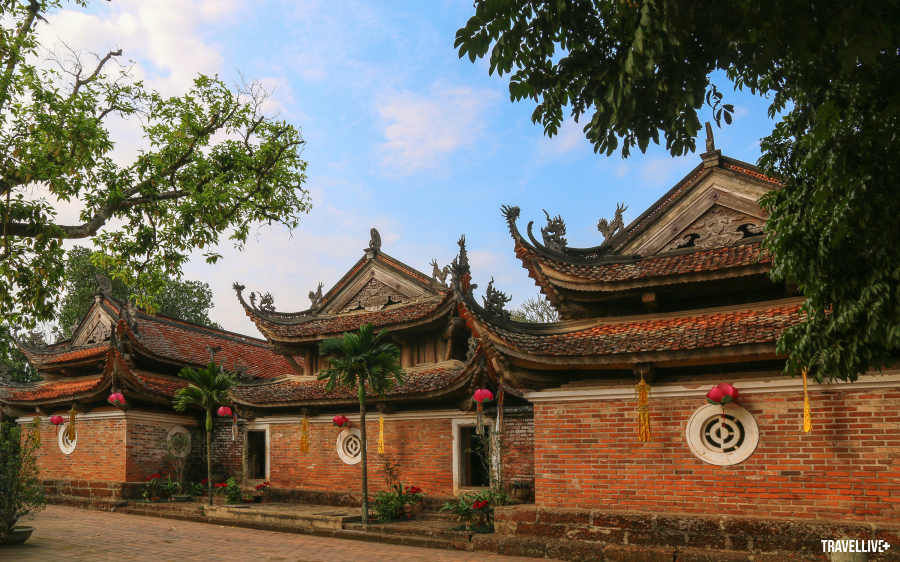
Perfume PagodaHuong Son commune, My Duc district. Huong Pagoda is a large cultural complex including a system of temples, pagodas, rivers, mountains, caves, grottoes... combined to create a valuable and rich flora and fauna ecosystem spanning across 5 villages: Yen Vy, Duc Khe, Hoi Xa, Tien Mai and Phu Yen and divided into three main routes: Thien Tru - Huong Tich; Long Van - Thanh Son; Bao Dai - Tuyet Son. With such a majestic terrain and landscape, the annual Huong Pagoda festival lasts from January 6 to the end of the third lunar month, welcoming tens of thousands of visitors to worship Buddha. Up to now, Huong Pagoda still preserves many valuable ancient artifacts such as stone steles, bronze bells, Buddha statues, most notably the green stone statue of Quan Am sitting on a mountain made in 1794, which is also a masterpiece in ancient stone sculpture. The entire Huong Pagoda complex is also classified as a special national architectural and artistic relic.

Thien Tru Bell Tower
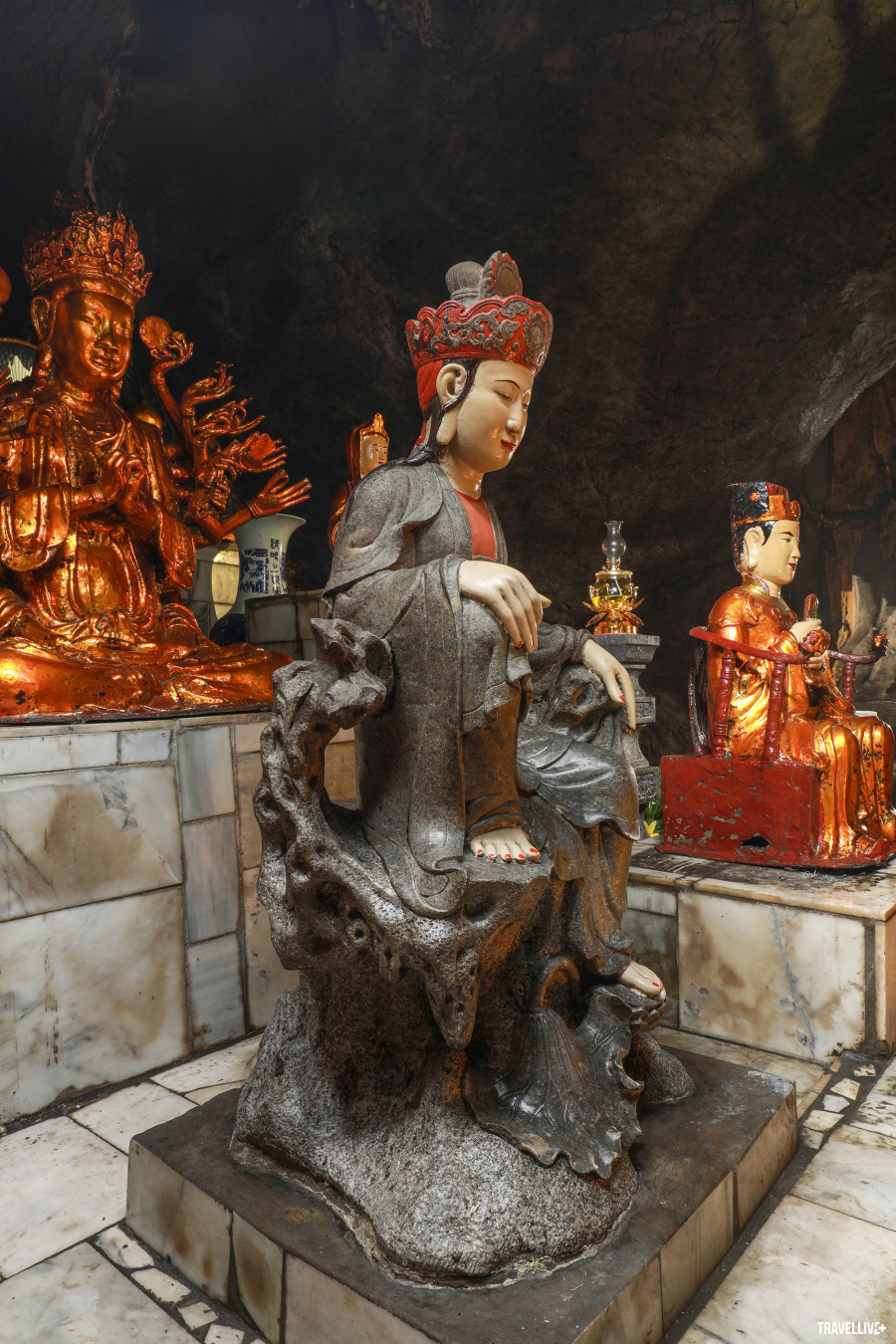
Stone statue of Guanyin sitting on mountain
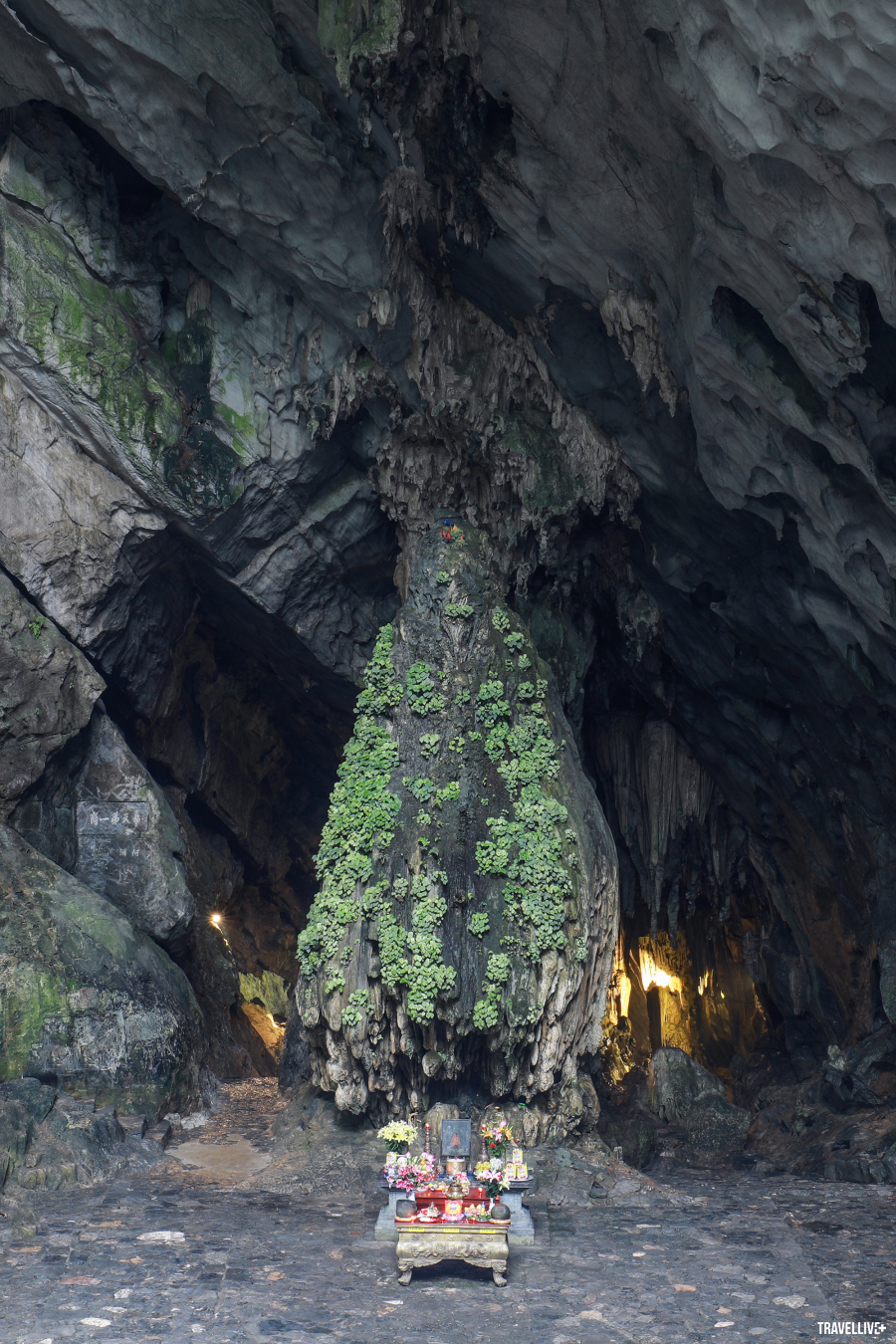
Huong Tich Cave
Temple - spiritual space "drinking water remember the source"
Vietnamese temples are also a type of religious architecture with the purpose of worshiping gods, kings, talented people or people with great contributions in history... so temples are also closely associated with the spiritual beliefs of Vietnamese people and are built everywhere. Ancient temples are often chosen in locations considered sacred, often quite independent and located on a large area of land with a quiet and majestic surrounding landscape of mountains or fields. However, up to now, due to the urbanization process, the temple grounds have been narrowed, even surrounded by houses. It is also not clear exactly when the temple was formed. Most of the ancient temples today have the architectural style of the Later Le Dynasty, the Nguyen Dynasty and very few temples still retain part of the architectural structure of the Mac Dynasty.
Soc Templebelongs to Phu Linh commune, Soc Son district. The temple worships Saint Giong, the legendary hero who defeated the An invaders, and has been ranked as a special national architectural and artistic relic. The Soc temple relic site is isolated and hidden in a vast mountainous area with a solemn and ancient landscape. With such a location, the space of Soc temple brings a feeling of relaxation and peace. The current architecture of Soc temple is in the style of the Nguyen Dynasty, with many items such as Ha temple, Thuong temple, Dai Bi pagoda, Mau temple and Non Nuoc pagoda. Most of the items of the temple are small in scale, in harmony with the surrounding trees and grass. Only Non Nuoc pagoda on the mountain has been expanded with a rather large scale.
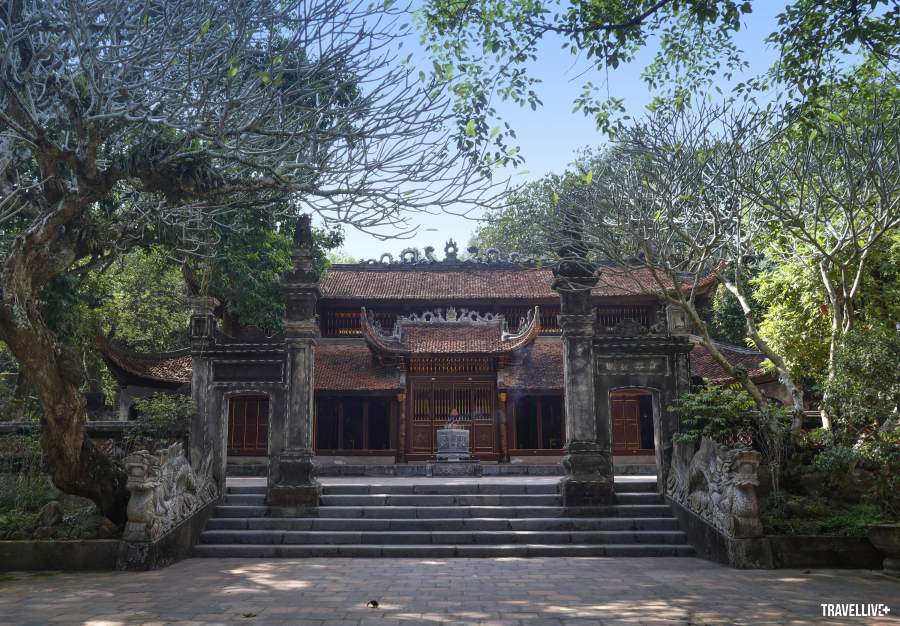
Upper Temple
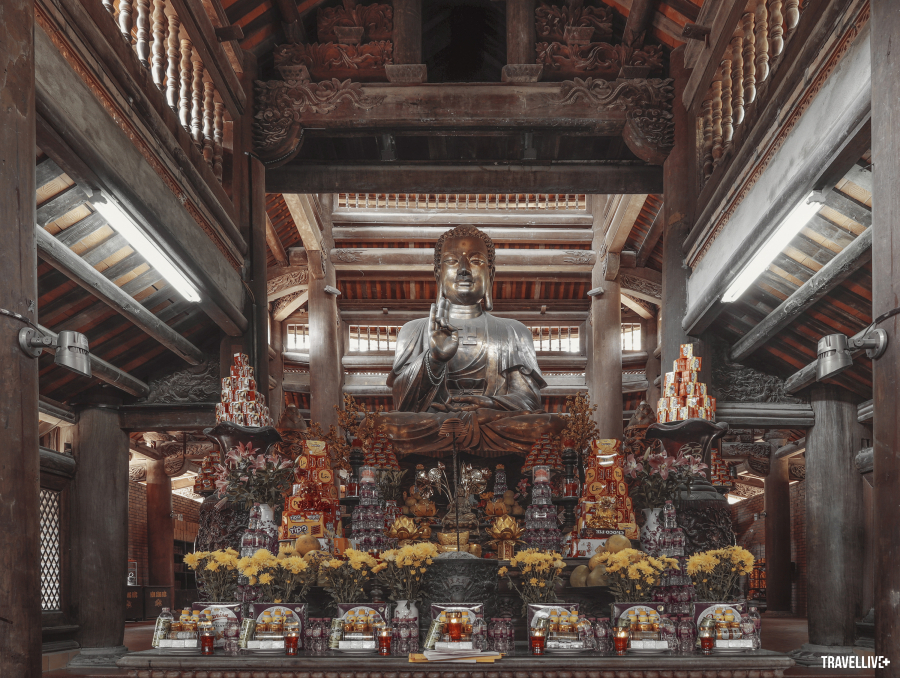
Non Nuoc Pagoda
Phu Dong Templeis also a place to worship Saint Giong in Phu Dong commune, Gia Lam district. The temple faces the Duong river dike, in front of which is a lake. The temple has all the items: water pavilion, five gates, square pavilion, front hall, middle hall, rear hall, left and right panels and more or less still retains the architecture of the Le Trung Hung period with many carvings of dragons and animals... Outside the five gates is a pair of dragons, inside is a pair of standing kylin. Both dragons and kylin were created around the 18th century, both made of stone with a strong folk character, looking funny and gentle. In addition, the temple still preserves many ancient relics. With such values, Phu Dong temple is also ranked as a special national architectural and artistic relic.
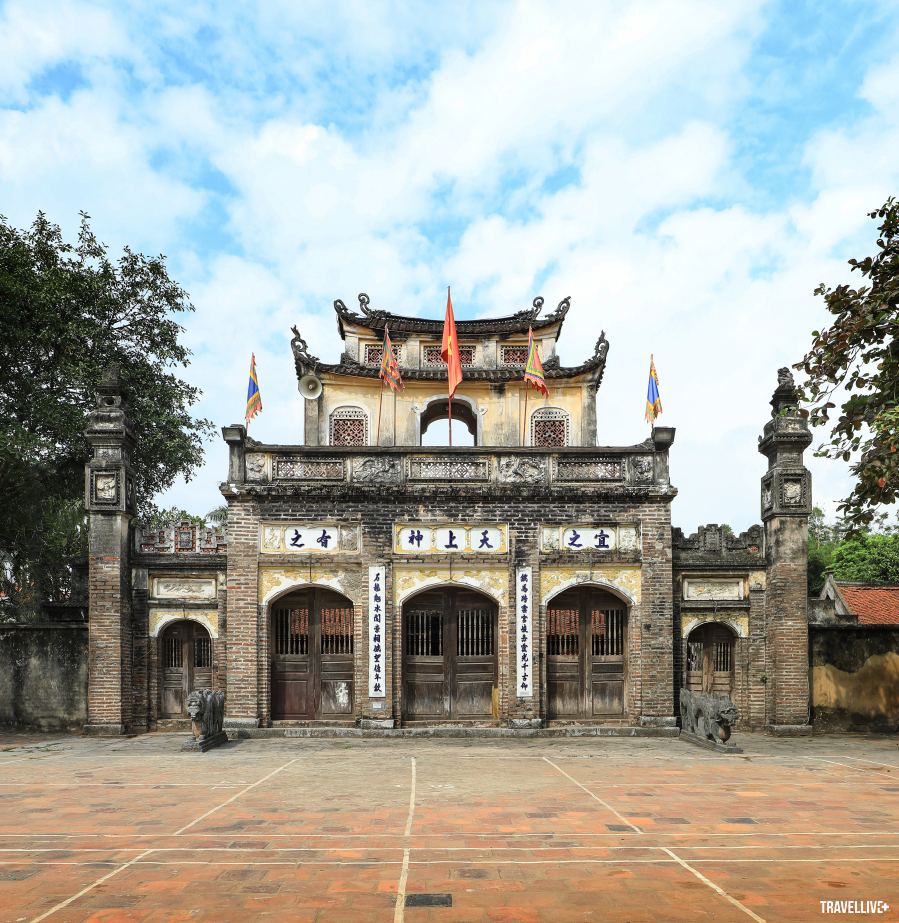
Five Gates
Hai Ba Trung Templebelongs to Ha Loi village, Me Linh commune, Me Linh district. The temple worships the Trung Trac and Trung Nhi, two national heroines who overthrew the Eastern Han Dynasty in the years 40-43. The temple is located on a high, wide area, overlooking the Red River dike with immense rice fields on both sides. The scale of the temple has many items such as the outer gate, inner gate, drum tower, bell tower, the Trung Sisters' temple, the temple of the two Ladies' father and mother, the temple of female generals, the temple of male generals, crescent lake, elephant eye lake, elephant trunk stream, elephant bathing lake and the vestiges of Me Linh ancient citadel - it is said that in the past, a palace was built here. The current architecture of the temple is mainly Nguyen Dynasty style architecture. In addition to ancient stone relics outside such as elephants, stone horses, stone dragons, the temple also preserves many ancient wooden relics such as palanquins, altars... Hai Ba Trung Temple is also ranked as a special national architectural and artistic relic.
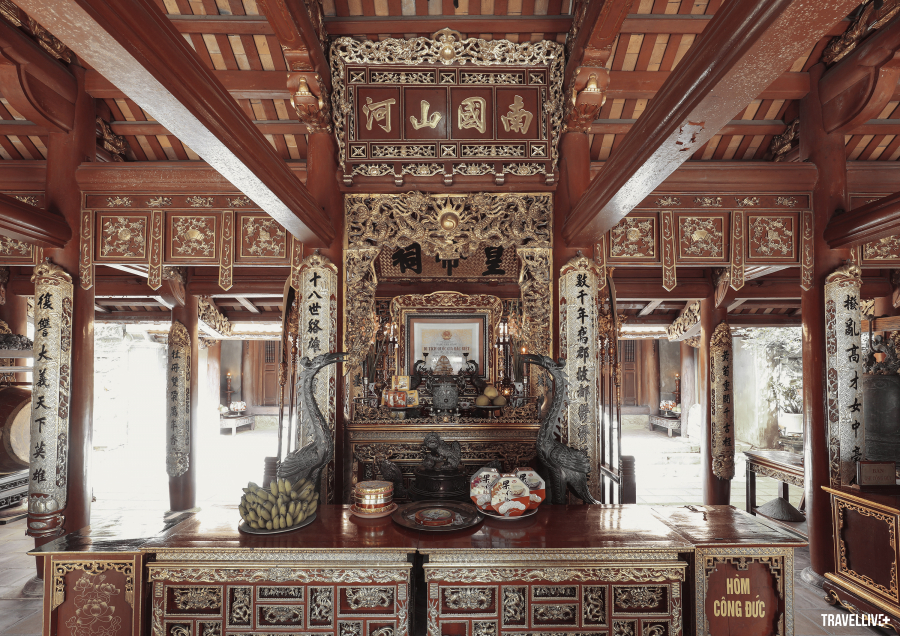
Communal house - The most typical feature of ancient Vietnamese architecture
The communal house is the most important nucleus in a Vietnamese village. Pagodas and temples are two types of structures associated with religious beliefs since their formation, but communal houses are not. Initially, they may have been just communal houses, which were originally public houses for resting, but communal houses gradually developed into places for cultural activities of the whole village. Communal houses are increasingly closely connected and revolve around the lives of villagers. In a village, the communal house is the largest and most imposing architectural work. The communal house often contains all thoughts and aspirations through the carved art images expressed by the people during the process of building the communal house. Therefore, it can be said that the communal house is the most typical and characteristic face of ancient Vietnamese architecture. Currently, like pagodas and temples, ancient communal houses have also changed somewhat from the beginning. The communal house considered to be the earliest still existing today is Thuy Phieu communal house in Ba Vi. The communal house still retains many architectural structures with carvings in the artistic style of the Mac Dynasty. In addition, the communal house still has a main pillar engraved with three lines: "Dong village, Giap Nam, Dai Chinh second year, Tan Mao year, twelfth month, so that day, tu ly" meaning: "On the seventh day of the twelfth month of the year Tan Mao, Dai Chinh second year (1531), Giap Nam, Dong village repaired the communal house".
Tay Dang communal houseFormerly belonging to Ke Dang, Quang Oai prefecture, now Tay Dang town, Ba Vi district. The communal house has been ranked as a special national architectural and artistic relic. Although the specific construction date has not been determined, through research, Tay Dang communal house also has the architectural art style of the Mac dynasty. Tay Dang communal house has a small but quite complete campus, complete with a four-pillar gate, left and right wings, a main hall and a crescent lake. Compared to Thuy Phieu communal house, the carved architecture of Tay Dang communal house remains quite intact and complete. The carved panels are quite thick in the artistic style of the Mac dynasty, depicting themes of people, dragons, phoenixes, animals and many lively scenes. The most prominent are the wooden panels carved with soft floral motifs that seem to be swaying in the wind. Many carved panels here have been included in books by famous researchers. It can be said that Tay Dang communal house is typical of communal house architecture with the artistic style of the Mac dynasty (16th century).


Chu Quyen communal houseFormerly belonging to Chu Chang village, Chau Chang commune, Quang Oai prefecture, so it is often called Chang communal house, now belonging to Chu Minh commune, Ba Vi district, Hanoi city. The communal house has a beautiful surrounding landscape, surrounded by rice fields, in front of a large lake. Chu Quyen communal house is a typical communal house of the architectural period with the artistic style of the Le Trung Hung period (17th century). The main architecture is a large communal house consisting of three compartments and two wings with a facade with a fairly high roof ratio, about twice that of the communal house body. Currently, the communal house still retains its architecture quite intact, the carvings, communal house floor and column system are very large. Dragons are carved on many architectural structures according to folk themes such as "dragon nest", "dragon jaw tomb" in the art style of the Le Trung Hung period with the formation of carvings in the style of swords and spears. Round statues are also a prominent theme of Chu Quyen communal house, depicted on the pillars depicting people riding tigers, elephants... very vividly, with high artistry. In particular, the round statue carved with a phoenix seems to tell the story of a mother hen protecting her chicks, which has not been seen in other communal houses.


So TempleFormerly belonging to Son Lo commune, Tien Lu canton, Quoc Oai prefecture, Son Tay province, now belonging to Cong Hoa commune, Quoc Oai district, Hanoi city. The earliest traces left in So communal house date back to the 17th century but not many, and the current architecture mainly bears the Nguyen dynasty's art style with a fairly large scale. So communal house is located on a charming feng shui site, with a very beautiful landscape. In front of the communal house is a large crescent lake surrounded by an arc-shaped dike. On the crescent lake is a rectangular communal house yard connected to the main gate with a row of stone steps with dragon-carved steps. After the main gate is the inner yard and then the main hall, the whole is surrounded by auxiliary works around, creating a ground plan in the style of "inner Public, outer National". The carvings in the main hall are mainly dragons, phoenixes, unicorns and the four noble plants "pine, chrysanthemum, bamboo, apricot". Although not as ancient as Tay Dang and Chu Quyen communal houses, So communal house always leaves a strong impression on visitors thanks to its beautiful architectural landscape.
